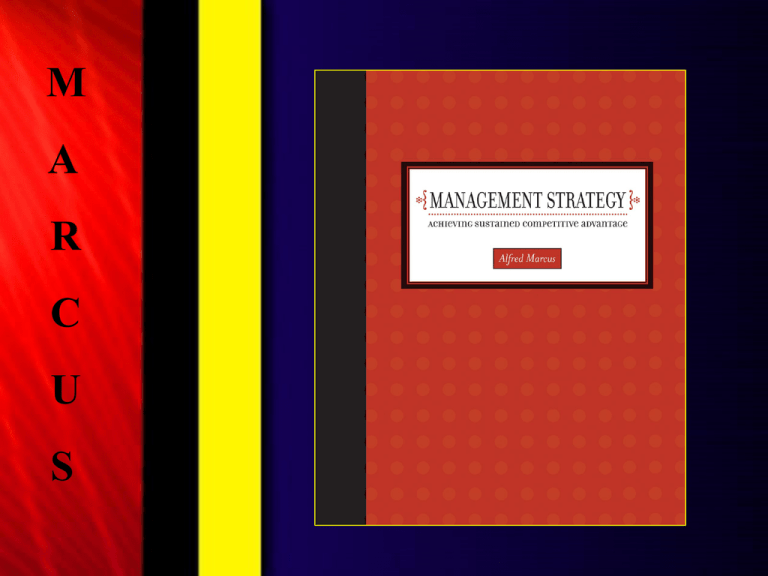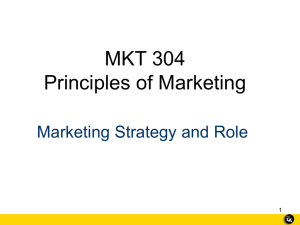
M
A
R
C
U
S
4-2
4
TIMING AND
POSITIONING
McGraw-Hill/Irwin
© 2005 The McGraw-Hill Companies, Inc., All Rights Reserved.
4-3
Chapter Learning Objectives
Understanding strategy as a series of moves and
countermoves.
Being aware of the importance of timing in making these
moves.
Gaining an elementary comprehension of game theory
and its contribution to strategy.
Being aware of four generic positions: (I) low cost to a
narrow group; (ii) premium product to a narrow group; (iii)
low cost to a broad group; and (iv) premium product to a
broad group.
McGraw-Hill/Irwin
© 2005 The McGraw-Hill Companies, Inc., All Rights Reserved.
4-4
Chapter Learning Objectives
(Continued)
Understanding the increasing importance of a best-value
position, which combines low cost and differentiation.
Recognizing examples of company repositioning.
Explaining strategic groups and the variety of ways a
product or service can be segmented.
McGraw-Hill/Irwin
© 2005 The McGraw-Hill Companies, Inc., All Rights Reserved.
4-5
Ex. 4.1
Timing Matters Advantages for
Early Movers
Head start on
competitors
Large percent of
valuable early
adopters
Customer loyalty
McGraw-Hill/Irwin
Late Starters
Reverse engineering
Less risk
Lower development
costs
Fewer mistakes
© 2005 The McGraw-Hill Companies, Inc., All Rights Reserved.
4-6
Ex. 4.2
Innovators Versus Followers
(Selected)
Product
Innovator
Follower
Winner
35mm camera
Commercial jets
Ballpoint pen
Light beer
CAT scanner
Float glass
Instant photos
Fiber optics
VCRs
Leica
De Havilland
Reynolds
Rheingold
EMI
Pilkington
Polaroid
Corning
Sony
Canon
Boeing/Airbus
Bic
Miller
GE
Corning
Kodak
Many
Matsushita
Follower
Followers
Follower
Follower
Follower
Innovator
Innovator
Innovator
Follower
McGraw-Hill/Irwin
© 2005 The McGraw-Hill Companies, Inc., All Rights Reserved.
4-7
Ex. 4.3
Competitive Landscape
Fundamental changes
•Globalization
•Deregulation
•Technological advances
•Importance of knowledge
Keys to Success
•Flexibility
•Innovation
•Speed
McGraw-Hill/Irwin
RELENTLESS & UNCEASING PACE
Blurring of traditional industry
boundaries, e.g.
•Computers
•Telecoms
A“Dynamic
Capability”
© 2005 The McGraw-Hill Companies, Inc., All Rights Reserved.
4-8
Ex. 4.4
Simultaneous Game: Payoff Matrix
My Company
Old product
Old Product
Old and New
Product
$100/
$100
$250/
$-30
$ -30/
$250
$0/
$0
My Rival
Old and New
Product
McGraw-Hill/Irwin
© 2005 The McGraw-Hill Companies, Inc., All Rights Reserved.
4-9
Ex. 4.5
Prisoner’s Dilemma: Payoff Matrix
Prisoner 1
Quiet
Quiet
Squeal
1 year sentence/
1 year sentence
free
6 year sentence
Prisoner 2
Squeal
McGraw-Hill/Irwin
6 year sentence/
free
3 year sentence/
3 year sentence
© 2005 The McGraw-Hill Companies, Inc., All Rights Reserved.
4-10
Ex. 4.6
Sequential Game Decision Tree
My Company
old & new (1st)
old
My Rival
old
01
old & new (1st)
02
old 03
old & new (2nd)
04
My Company
old
05
McGraw-Hill/Irwin
old &
old
st
new (1 )
06
07
old &
new (2nd)
08
© 2005 The McGraw-Hill Companies, Inc., All Rights Reserved.
4-11
Learning From Game Theory
• Identify all the competitors in a game
• Try to understand all of their options
• Try to compute the payoffs from the various
decisions that can be made by combining
options
• Try to understand the sequence of possible
moves
McGraw-Hill/Irwin
© 2005 The McGraw-Hill Companies, Inc., All Rights Reserved.
4-12
Arguments for Being a First Mover
The lags in time it will take a second mover to catch
up, during which the first mover can earn substantial
profits
The ability during these lags to erect learning and
scale barriers to entry
The ability to establish a reputation and to erect
switching costs that make it hard for customers to
abandon the firm
The preemption of scarce assets and resources,
such as raw materials and distribution channels,
which a second mover cannot obtain
McGraw-Hill/Irwin
© 2005 The McGraw-Hill Companies, Inc., All Rights Reserved.
4-13
Ex. 4.8
Porter’s Sources of Competitive
Advantage
COST
ADVANTAGE
Similar product
at low cost
COMPETITIVE
ADVANTAGE
DIFFERENTIATION
ADVANTAGE
McGraw-Hill/Irwin
Unique product
at premium price
© 2005 The McGraw-Hill Companies, Inc., All Rights Reserved.
4-14
Ex. 4.9
Porter’s Generic Strategies
Narrow
(One Group of
Customers)
Low
Cost
Differentiated
McGraw-Hill/Irwin
Broad
(Many kinds of
Customers)
Focused Cost
Leadership
Broad Cost
Leadership
Focused
Differentiation
Broad
Differentiation
© 2005 The McGraw-Hill Companies, Inc., All Rights Reserved.
4-15
Ex. 4.10
McGraw-Hill/Irwin
Positioning in Retail
© 2005 The McGraw-Hill Companies, Inc., All Rights Reserved.
4-16
Ex. 4.12 Low-Cost and Differentiation Strategies:
Resources and Capabilities
Generic Strategy
Cost Leadership
Differentiation
Scale-efficient plants
Access to capital
Control of overheads and R&D
Avoidance of marginal customer
accounts
Branding/brand advertg.
Custom design
Special services
Unique quality features
Resources
McGraw-Hill/Irwin
© 2005 The McGraw-Hill Companies, Inc., All Rights Reserved.
4-17
Ex. 4.12 (Continued)
Generic Strategy
Cost Leadership
Differentiation
Design for manufacturing skills
Process engineering skills
Frequent reports
Tight cost control
Specialization of jobs/functions
Marketing product
Engineering creativity
Product R&D
Qual. measure/incentives
Strong cross-func. coord.
Capabilities
McGraw-Hill/Irwin
© 2005 The McGraw-Hill Companies, Inc., All Rights Reserved.
4-18
Ex. 4.13 Best Buy: From a Differentiated to a Best-Value
Strategy
Narrow
Low-Cost
Narrow
Differentiated
McGraw-Hill/Irwin
Best Buy superstore
format
Best Buy –
‘Sound of
Music”
specialty store
Best Buy –
Mass market
commodities plus
specialty
items/myths
(a hybrid)
Best Value
© 2005 The McGraw-Hill Companies, Inc., All Rights Reserved.
4-19
Ex. 4.14 Schwab and Morgan Stanley: From
Polar Opposites to the Middle
Low-Cost
Schwab- Responding to
threat after emergence of
Online brokers
The
Middle
Differentiated
McGraw-Hill/Irwin
Morgan Stanley –
Responding to
opportunity after purchase
of Dean Witter
© 2005 The McGraw-Hill Companies, Inc., All Rights Reserved.
4-20
Ex. 4.15 Ivory: From a Differentiated to a Low-Cost
Strategy
Low-Cost
Ivory –
After Dial and Dove
Challenges
Differentiated
Ivory –
Before Dial and
Dove Challenges
McGraw-Hill/Irwin
© 2005 The McGraw-Hill Companies, Inc., All Rights Reserved.
4-21
Ex. 4.16 Forest Labs Changes Strategic Groups in the
Pharmaceutical Industry
Low-Priced
Generics
Forest Labs –
Before Celexa competes with:
Barr Labs, Biovall, Mylan
Labs, and Watson
Pharmaceuticals
High-Priced,
Patented
Drugs Based on
a High Level of
R&D
Forest Labs –
After Celexa competes with:
Pfizer, Merck, Abbot Labs,
GlaxoSmithKline, and Eli Lilly
McGraw-Hill/Irwin
© 2005 The McGraw-Hill Companies, Inc., All Rights Reserved.





